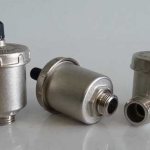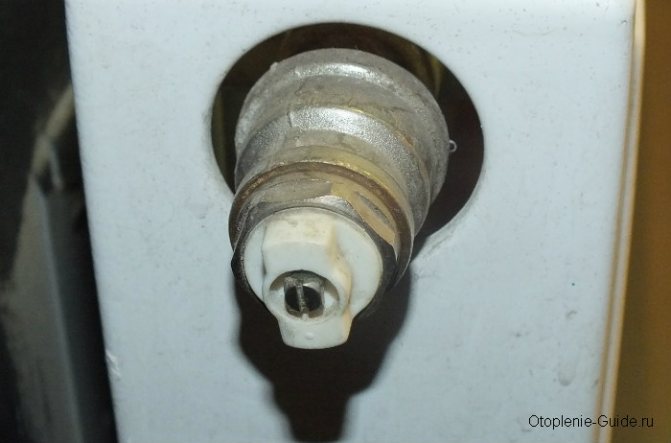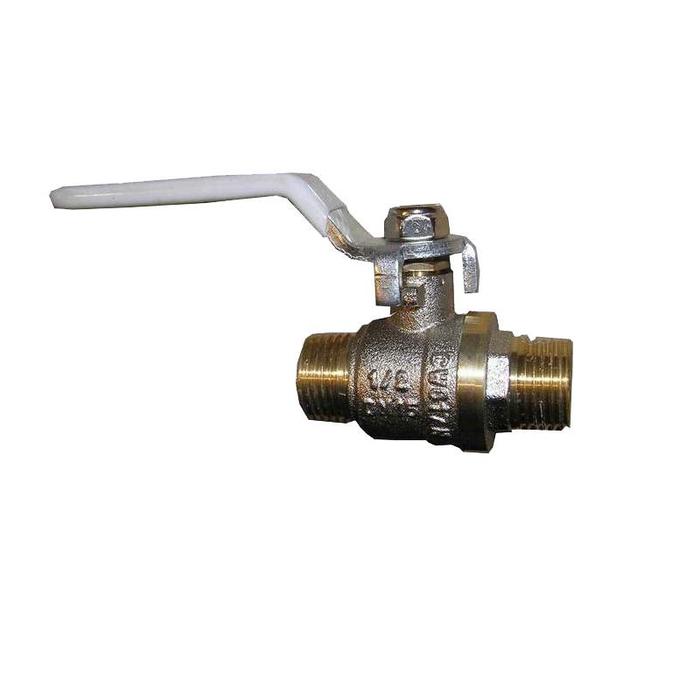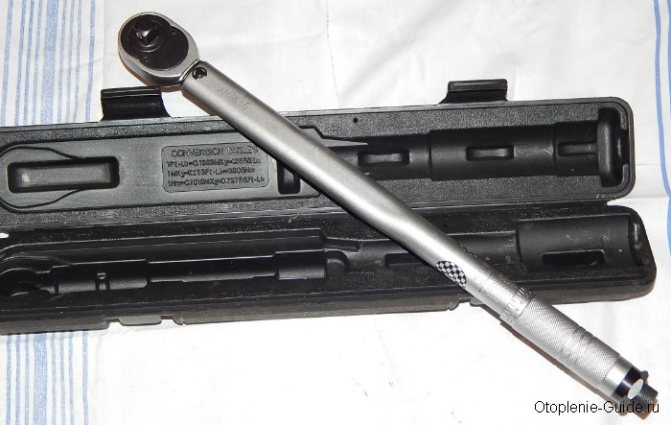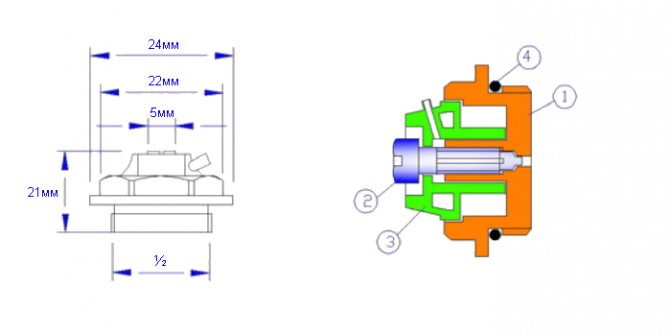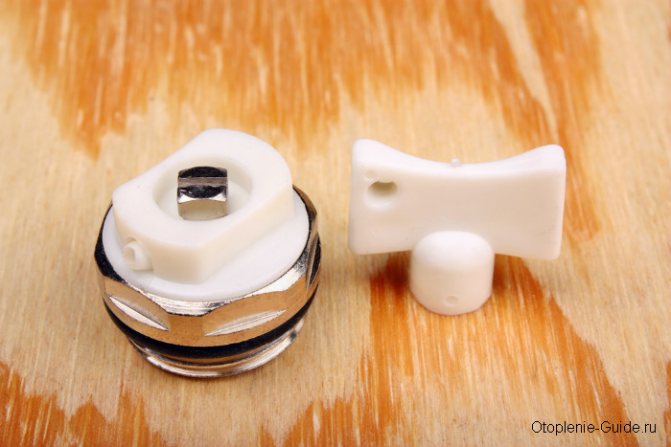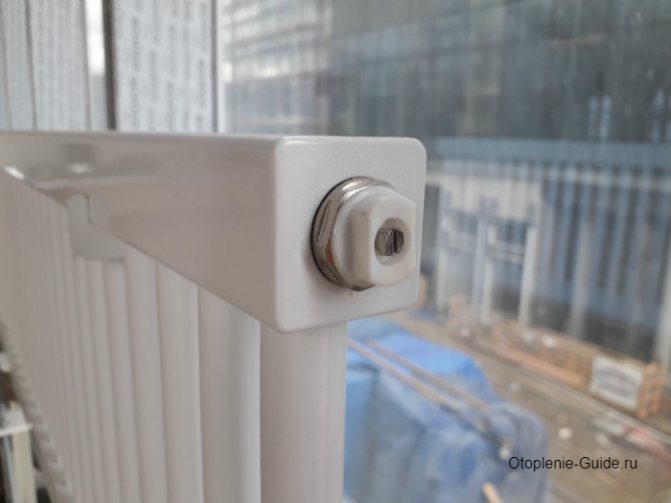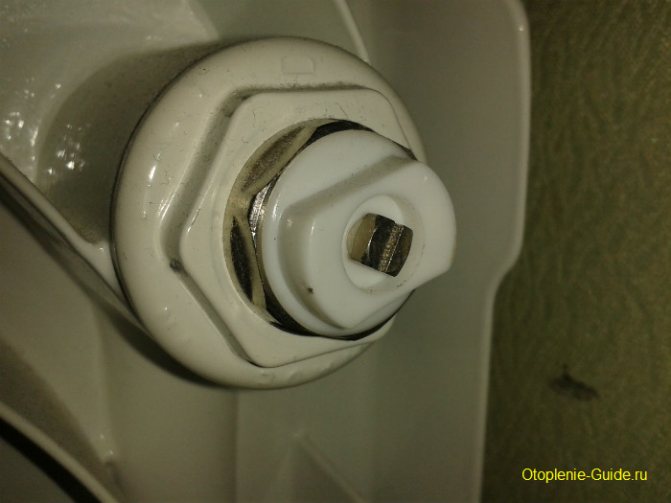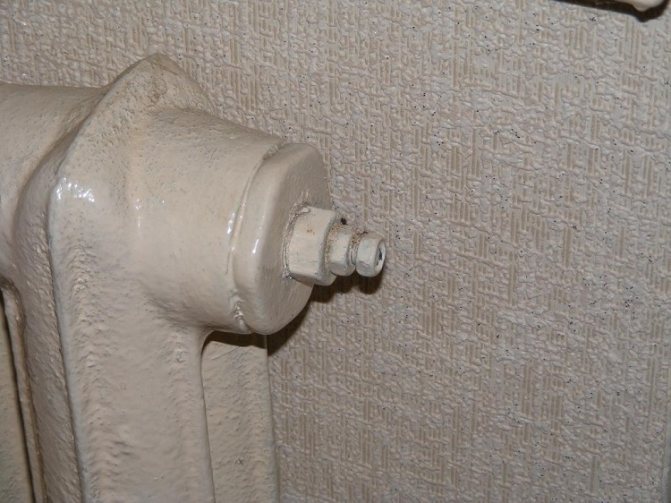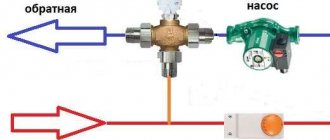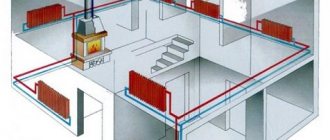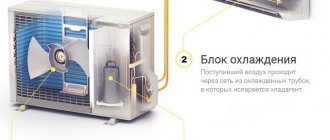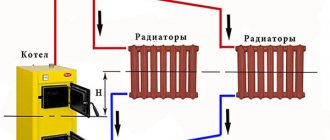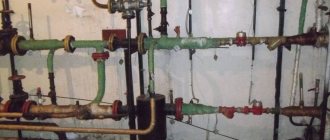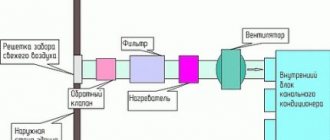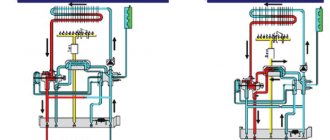On which radiators it is necessary to install gas vents
Installation on aluminum batteries is required. When aluminum comes into contact with a coolant, water decomposes into components, one of which is hydrogen. Therefore, it is imperative to remove gases in such heating devices.
Installation on partially bimetallic radiators is also desirable. In them, the contact area of aluminum with the coolant is greatly reduced, but it is still present. Therefore, the installation of the Mayevsky crane is desirable.

It is a straight and angle automatic air vent. They can also be put on radiators, only the "pimp" should look up
Fully bimetallic radiators are safer in this regard: their entire core is made of steel. But many manufacturers require such a device in their installation recommendations.
These devices are ineffective on cast-iron radiators of old forms. In them, air removal is possible only together with a sufficiently large amount of coolant. And these devices (both manual and automatic) are not adapted to this. In this case, standard or ball valves are installed to bleed air.
With tubular radiators and registers, the situation is about the same as for cast iron: only taps work effectively. Therefore, it makes no sense to put air vents on them.


This is a needle air vent valve, or a "Mayevsky" valve
Installation of Mayevsky cranes on steel panel radiators is mandatory. The fact is that the passages for the circulation of the coolant have a small diameter. And if an air lock forms, the movement of the coolant will be blocked. It will stop heating completely or partially. The plug can only be removed by draining most of the coolant and filling it again. Therefore, most often panel radiators come directly from the factory with air vent valves.
Output
Today you learned about such a wonderful device as an air vent. Examples were given - what is the device for and where it is used. Since its sizes are different, you just have to choose the appropriate one, for example, a Mayevsky 3 8-inch crane, half an inch or another option. Installation of the device does not cause problems, large financial expenditures, effort and time and effort.
With the help of such a device, it is possible to seriously increase the heating efficiency. The video in this article will provide an opportunity to find additional information on the above topic.
Did you like the article? Subscribe to our channel Yandex.Zen
Types and technical characteristics
According to the method of diversion, these devices are of two types:
- manual;
- automatic.
They are made with different diameters. The most common are 1/2 "and 3/4" (half-inch and three-quarter inches). There are still 1/8 ", 1/4" and 3/8 "in nature, but they are not used in our systems. Most often, modifications are used with a half-inch diameter 1/2 ", in another system of units it is also called DN 15. In this case, the number 15 is the designation of the connecting size in millimeters.
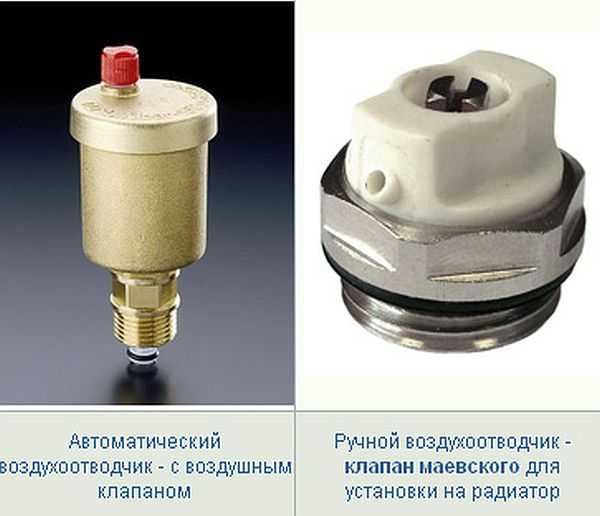

Manual and automatic device for removing gases from the heating system
In addition to diameters, the following parameters are also important:
- Operating pressure. In most models, it is 10 atm, there are devices designed to work at 16 atm.
- The type of working environment. There are air valves, there are those working with liquids. Heating systems use fluids or universal (both air and liquid).
- Working environment temperature. Most often they are found with an operating temperature of 100 oC - 110 oC. There are some that work up to 150 oC.
- Thread type: external or internal.
These technical characteristics of the air ducts must be matched to the existing type of system. For individual heating systems, any are suitable, but when choosing devices for radiators powered from centralized systems, you need to know both the pressure and the temperature for your house (check with the housing department, DEZ, ZhEK, etc.).
Crane selection criteria
The plumbing market today is rich in various offers, everyone can find what suits him in terms of price and quality. When buying and installing stop valves, you should clearly understand what the valve is for, and not clutter up the structure with unnecessary details - this is not only expensive, but it will also have a bad effect on the operation of the entire heating system.
Taps for radiators are selected taking into account the type of device that is used as a heat carrier, as well as the type of circuit of the heating system.
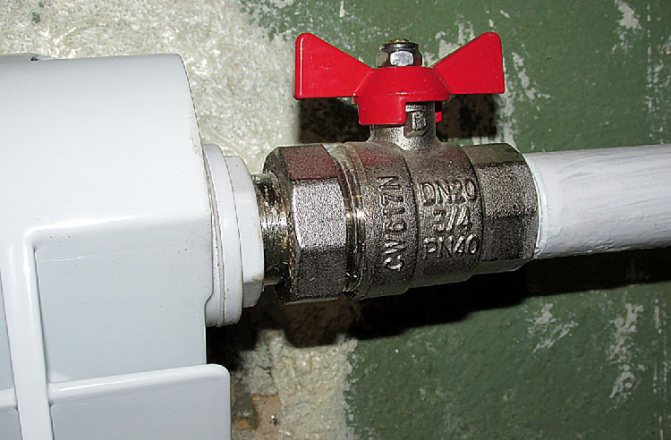

Pipes of the appropriate diameter should be selected to minimize the number of valves used, and valves with the maximum capacity should be selected.
The strongest and most durable materials used in the manufacture of valves are steel and brass. These are thick-walled products that will last longer, but when choosing it is important to pay attention to the quality of the gaskets.
Note! Modern sealing gaskets, which are used when installing taps, are made not of rubber, but of silicone, since this material is not subject to destruction and does not lose elasticity when exposed to high temperatures, and as a result, it lasts longer than rubber.
An important selection criterion is the manufacturer of the product. As a rule, the goods of well-established brands with a worldwide reputation are an order of magnitude superior to their counterparts of little-known manufacturers. Firms whose products have been tested in domestic conditions and have positively proven themselves:
- Italian companies Itap and Luxor;
- German company Oventrop;
- Danish manufacturer Danfoss;
- joint Russian-Italian company Valtec.
We recommend that you familiarize yourself with: The use of an American crane in pipelines of various types
The principle of operation of the automatic air vent
The designs of these devices may change, but the principle of operation remains the same. The device is a hollow cylinder, which consists of two parts - upper and lower. They are connected to each other by means of a thread, the tightness is ensured by a rubber (silicone) O-ring. There is a small cylindrical hollow protrusion at the top. Air exits the system through this protrusion. It has a thread on which a plastic (polypropylene) cover is screwed. With this cover, you can, if desired, stop the bleeding of air (screw it on).
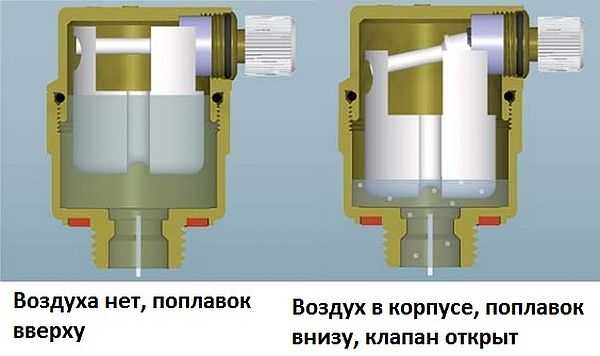

One of the devices is simple and effective
The operation of the automatic air valve is based on the buoyancy of a float placed inside. The float is connected to a rod that acts on a spring-loaded spool that closes the outlet. If there is no air in the system, the air vent body is filled with coolant, the float has risen up. In this position, the rod supports the spool, and air does not come out (and does not enter). When air appears in the system, the coolant is gradually displaced, the float goes down. The rod does not push the spool as hard and the spring opens the outlet. The accumulated gas comes out, the coolant is again recruited into the body, the valve closes.
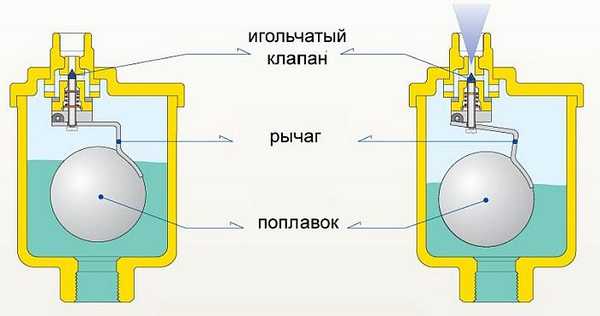

One of the models with a more complex spring-loaded air release mechanism
In devices of different companies, the mechanism of action on the spool is different, but the principle is unchanged: the float is at the bottom, the valve is closed, when it rises, it is open. The principle of operation of one of the modifications is demonstrated in the video.
device, principle of operation, types, features of installation and maintenance
One of the most common causes of a heating system malfunction is air accumulation. The blockage prevents the water from circulating freely. As a result, the radiator with accumulated air does not fulfill its function, and the efficiency of the entire system decreases. More than eighty years ago, the Mayevsky crane was invented, which allows you to easily and conveniently "air out" heating communications. Despite its simplicity, this device is effective and reliable, therefore it is used in systems today. Let's take a closer look at its structure and principles of operation.
The device of the Mayevsky crane and the principle of its operation
This plumbing device is called Mayevsky's crane only in the folk environment. In state standards, it belongs to the category of shut-off valves, called a needle radiator air valve.
Now the industry offers several designs of the Mayevsky crane. This allows you to choose the most convenient option, taking into account the location of its installation. The classic design is a two-piece device:
- conical screw;
- housing.
The elements fit tightly to each other due to calibration, therefore, when closed, the valve reliably holds the coolant. An air vent is located on the side of the case.
Mayevsky's taps are most often made of brass. This alloy has a high degree of corrosion resistance, which guarantees a long service life. Depending on the type of design, the Mayevsky crane can be opened with a special ICMA key, a screwdriver or by hand.
In a vertical heating system, consisting of a lower water supply pipeline and an upper thread for removing the coolant, all appliances located on the upper floor are equipped with such elements. Mayevsky's taps are selected by diameter and screwed into the upper radiator fittings. In a horizontal heating system, these devices are installed on each battery. A tee is used for a side connection heated towel rail in the bathroom. It is installed vertically with the tap hole facing away from the wall. Installation of Mayevsky taps on radiators, convectors is necessary if there are sections in the heating system that are located lower than the upper axis of the device connection. In this position, natural air removal is not possible.
Mandatory de-airing is carried out immediately after the installation of the heating system, since at the beginning of work in the radiators, plugs accumulate in any case. It is required to carry out such work when turning on the system after the summer. Subsequently, local problems may arise due to the suction of air into the system, which occurs during its operation, the presence of air bubbles in the coolant. The reason for the accumulation of air is the release of hydrogen during the corrosion of the metal parts of the communication. Aluminum radiators without a specific coating of the inner surface constantly emit this element into the coolant, entering into a chemical reaction with it.
Before carrying out work, you need:
- Prepare a container for water and a rag so as not to flood the floors in the room;
- Remove air if necessary. Mayevsky's crane is turned counterclockwise by one turn by hand, a screwdriver or a key. At the same time, air begins to hiss out of the radiator. If there is a lot of it, you can turn the tap another half turn. In the open state, it is left until it starts to drip from the hole, and then water flows out, and the air stops coming out.
- The tap can then be closed tightly. If the system is equipped with pumps, for forced circulation, they must be turned off a few minutes before air bleeding.Otherwise, it will not be possible to completely remove the plug, so the air will not have time to accumulate in the upper part of the radiator.
Mayevsky's manual crane is usually not used in large highways, where the accumulation of air locks occurs constantly. For such systems, other gas venting structures are used.
Mayevsky's automatic crane
Mayevsky's manual crane is easy to operate, there are no difficulties with it even for those who have never been involved in servicing heating systems. But in places where airing of the system occurs regularly, it is advisable to install an automatic air vent. Such a problem can happen if the installation of heating pipes was carried out incorrectly. The valve with an automatic venting function eliminates the need to manually do this work regularly. This option is convenient for installation in hard-to-reach places.
The designs of automatic air vents can be different, but their principle of operation is the same. The body has a hollow compartment with a plastic float. With the help of a flag, he presses on the rod with a spring, access to the atmosphere opens, air comes out. When the cavity is filled with coolant, the float presses on the stem, closing the hole, preventing water from escaping.
For the convenience of carrying out repairs in the event of a malfunction or replacement of a worn out valve, the device is equipped with a shut-off valve. It is screwed into the heating system, then the air vent is screwed on. The crane presses the flag in the valve, eliminating the leakage of the coolant. Automatic air vents in stores are presented in a large assortment. They can be special, radiator, straight, angular. Therefore, you can choose such an element for any heating system.
Installation and maintenance of the Mayevsky crane
Installation of a Mayevsky crane does not require experience or high qualifications. You just need to choose the right size device. These plumbing fixtures can be 1 ", ¾", ½ "threads. The tap is located in the upper part of the radiator, on the side opposite to the coolant inlet. Before installing the taps, the water from the heating system must be drained. Then a plug is unscrewed in the radiator plug and a tap is mounted in its place. These devices are equipped with rubber O-rings, but it is advisable to use a winding during installation. For safety sealing, an FUM tape or linen fiber is wound on the thread.
Modern radiators have holes in the plugs for installing a tap, which simplifies the work. If the battery has a different type of plug without an air vent hole, it can be replaced. The tap must be installed in such a way that the hole is on the side opposite to the wall, pointing slightly downward. This will allow you to substitute the container when bleeding air and carefully collect the water. The choice of a manual or automatic air vent depends on personal preference and the characteristics of the heating system.
In old cast iron radiators, some preliminary work may have to be done to install the Mayevsky crane. In doing so, you need to know the following:
- to install a Mayevsky crane in an old cast-iron radiator, you need to drill a hole in the upper plug, cut a thread, then screw in an air vent;
- it is not recommended to install automatic Mayevsky taps on such radiators in the central heating system. In such communications, the coolant is very dirty, so the air vent will have to be cleaned often. In addition, heating is sometimes turned off in houses and air jams are often created;
- in central heating systems, water hammers are sometimes observed, with a force of up to 15 atmospheres.Therefore, special automatic air vents OMEC or MC-140 are required, which are capable of withstanding temperatures up to 150 degrees.
The Mayevsky crane is highly reliable and has been performing its function regularly for many years. But, if there is dirt in the coolant, the opening of the device may be clogged. In this case, it needs to be cleaned. It can be located directly in a brass body or in a special plastic lining. In any case, the accumulated dirt can be easily removed with an ordinary pin or needle.
If it is necessary to replace the damaged Mayevsky tap, you need to stock up with an adjustable or gas wrench, hold down and hold the radiator plug, since unscrewing the tap will loosen it.
The installation of Mayevsky's taps on the radiators of the heating system will not require serious financial costs, a lot of time and effort. But such an addition will greatly simplify the operation of communication and increase its efficiency.
The effectiveness of the Mayevsky crane (video)
Rate this article: Share with your friends!
septik.guru
Types of automatic air vents and their installation
These valves can be straight or angled, there are special models for radiators. Specialized or angled modifications are more often installed on batteries. They are screwed into the radiator manifold (if the diameter allows) or installed through an adapter.
Regardless of the type, install the device so that the outlet (cap) is directed upwards. There are two mounting methods:
- screw directly into the thread of the appropriate size;
- first put the shut-off valve, and then screw the air vent into it.


The shut-off valve is a small device. But it makes it possible to remove the air vent on a working system.
The shut-off valve has a spring-loaded gasket inside, which in the released state shuts off the coolant. When installing the air vent, the valve is pushed down, opening access to the system. It is very desirable to install this simple device in centralized heating systems. It allows you to remove the air vents without stopping and draining the system. And you will have to take them off for cleaning. In general systems, the coolant has a lot of impurities that settle and clog the spool and its supporting mechanism. If a lot of dirt is collected, the coolant begins to flow through the outlet. This means it's time to take it apart and clean it. This is where the shut-off valve comes in. With it, you simply unscrew the air exhaust device, the spring is released and seals the hole with a gasket.
When installing an automatic air vent, there are several rules:
- Use a regular wrench. The adjustable wrench cannot be used: the applied force is difficult to control.
- Hold on to the hex under the cylinder. You can't hold on to the body: you can break it.


Another type of automatic vent valve
A little about prices. It has a significant spread and depends on the manufacturer, the diameter of the connection (half-inch ones are about 10-15% more expensive), as well as on the material used. The cheapest models cost about $ 5, the most expensive ones cost $ 15. But in different stores, prices for the same models can vary greatly. For example, you can buy an automatic Danfoss DN 15 air vent for both $ 7.63 and $ 11.5. But, of course, you need to look carefully so as not to buy a fake. This is especially dangerous with well-known companies: Danfoss (Danfoss), Wind (Wind) or Valtec (Valtek).
We also give the prices for shut-off valves. There is also a spread, but not so significant: from $ 1.1 to $ 1.8.
Installation of cranes
The installation scheme depends on the type of selected shut-off and control valves.
Crane installation process
The following mounting options are most common
:
- In a one-pipe central heating system, 2 ball valves are placed between the radiator and the bypass - on the inlet and outlet pipes. This makes it possible to leave it filled when draining the coolant from the system during the network repair period, disconnect or dismantle the battery for painting, cleaning, replacement.
- In an autonomous two-pipe system, a thermostatic valve is placed on the supply pipe, and a balancing valve is placed on the return pipe, which will be responsible for maintaining normal operating pressure.
- In a stand-alone one-pipe system, a ball valve can be installed on the supply pipe, and a control valve can be installed on the return pipe. If the valve has a function to cut off the coolant flow, a second ball valve for the radiator is not required.
Installation of ball valves
Ball valves, which are installed on a heating radiator, have two operating positions: "open" and "closed". Partially blocking the flow of the coolant using this type of fittings is prohibited. As a result of improper use, the device may fail and begin to leak.
The device can be straight or angled - the choice depends on the system layout. If the installation of regulators is not provided between the shut-off valves and the radiator, the ball valve may be installed directly on the heater using a squeegee - a special additional part.
Before installation, make sure that the parameters of the device (operating pressure, maximum permissible temperature of the medium) correspond to the characteristics of the heating system. The direction of flow is indicated on the valve body - installation is carried out in accordance with the mark.
Manual way to remove air in batteries
And yet, manual models are more often put on radiators. And the most common of them is the Mayevsky crane. It is a small, simple and efficient device. It is also called a needle air vent valve.
It is a metal washer with a thread applied around the circumference. The washer has a through tapered hole with a thread. The hole diameter is very small. On the one hand, 1-1.5 mm (towards the radiator) and about 5 mm on the other.


Diagram of the "Mayevsky" crane
A locking cylinder is screwed into the hole, on which the thread is also applied. When closed, it shuts off the coolant flow completely. Unscrewing the cylinder, the cone is raised, the hole opens. If gases have accumulated in the radiator, they come out. If there are no gases, the coolant comes out. But there cannot be much of it: much will not flow into a hole with a diameter of 1 mm.
In some models, a plastic disc with a drain hole is attached to the body (the diameter is also about 1 mm). This disc rotates freely around the horizontal axis, which allows the drain hole to be set to a comfortable position.
Types of products
Let's consider what design options are used in systems and how they differ from each other.
Shut-off valves
This product variant has the following features:
- If necessary, you can shut off the coolant supply, this will allow you to quickly carry out repairs and replacements with your own hands without shutting down the entire system.
- Allows for gentle filling of the system, excluding pressure drops and water hammer due to the fact that the valve can be opened gradually.
Designs of this type allow you to make the system as flexible as possible, you can turn off any radiator, and the rest will work as usual
- The products have a very attractive appearance, so they will organically fit into the environment. The main thing is to choose the best option that matches the radiator.
- You should not use this option to adjust the flow of the supplied fluid., since it is not intended for this, and the required accuracy of settings is unlikely to provide. Such structures are needed to cut off part of the contour, if necessary.
As for the options, there are two of them:
- A ball valve for a heating radiator is a structure inside which a spherical assembly is located; in the open position, the hole in it is aligned with the pipe cavity, in the closed position, the flow is blocked. The main difference from standard options is the case, which is often covered with plastic and the adjusting knob, rather than a valve or lever, these factors provide a more attractive appearance of the product.
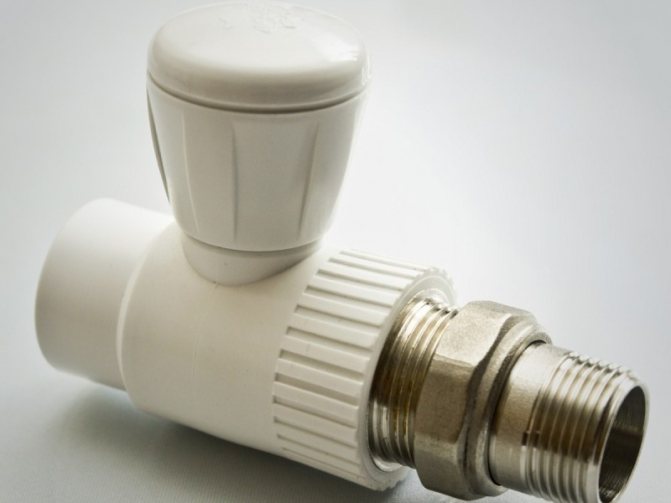

Ball valves are widely used
- The second option is valves, in which the mechanism is a stem with an attached cone, which, depending on the need, opens or closes the cavity. This option is also suitable for adjusting the intensity of circulation, but it is still better to use one of the options described below.


This is how the valve design looks from the inside
Important! All of the above options are available in both straight and angled versions, so you need to determine the system configuration in advance in order to purchase exactly the option that will be most convenient.
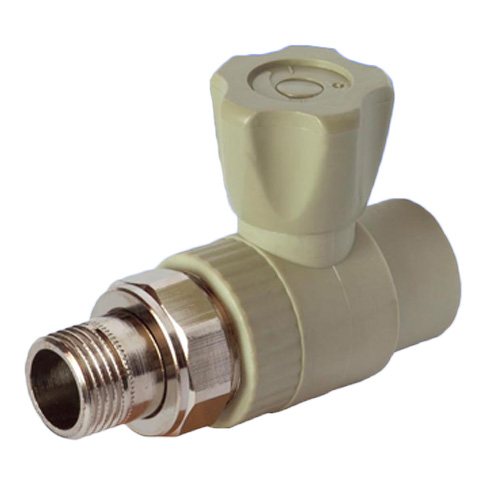

A straight radiator tap 3 4 made of polypropylene is a very popular option, since its price is low and the quality is good
Adjustment units
Here you should remember one simple recommendation - the control valve for the radiator is always installed behind the shut-off valve.
There are two options:
- Manual constructions, usually they have numbers indicating temperature conditions, in order to understand the meaning of each of them, read the information provided by the instructions included in the kit. The main advantages of such solutions are design simplicity and affordable price.
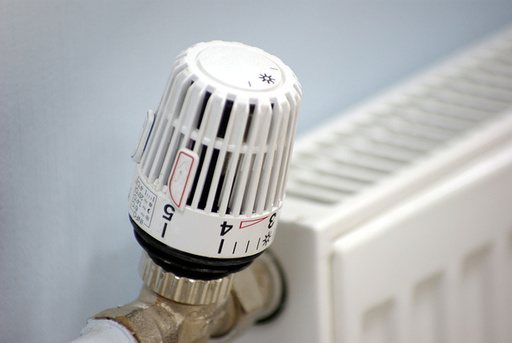

The control valve for radiators 3 4 can have from four to ten temperature settings
- Automatic thermo faucet for radiator - a more convenient solution that allows you to maintain the temperature in the room at a certain level, it is very convenient and allows you to create a comfortable microclimate in the room. The most modern models can adjust the temperature readings by time of day and day of the week, this allows you to reduce energy consumption and reduce heating costs.
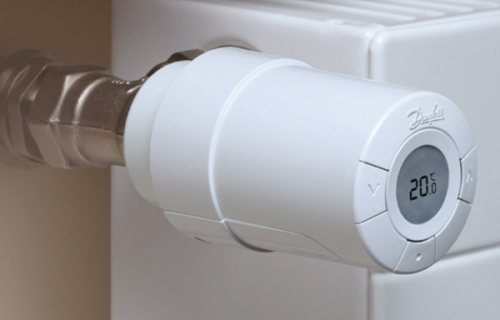

Thermostatic options are very easy to use
As for the device, it is similar to a classic valve, but unlike it, the valve does not move along the thread, but is pressed by a rod, which is acted upon by either a handle or a special thermal head, which reacts to changes in the room temperature and regulates the flow of the supplied coolant.
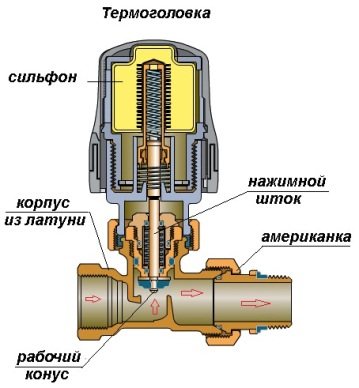

Radiator taps for smooth temperature control have a special assembly in the design - a bellows that responds to external conditions
Air taps
This type of product such as an air valve for radiators is an integral part of any modern system and allows you to remove excess air from the batteries, which from time to time accumulates in the structure.
The product is a housing with a special needle valve inside, the design is provided for holes with a diameter of ½ ", that is, about 15 mm, they are standard and, as a rule, fit most of the used radiators.
It looks like a Mayevsky crane
As for its use, everything is very simple here: with the help of a special key, you turn the stem, as a result of which the needle valve opens, and all the air comes out, when water flows from the tap, it must be closed.
Some people ask if there are air valves for radiators with a diameter of 25 mm, in this case, the simplest solution would be a ball valve with an air vent valve, since Mayevsky valves are not produced for this diameter.
This option will allow you to solve two problems at once.
How to use the Mayevsky crane
If you have collected air in the heating radiator, you need to take a special key (a small piece of plastic that comes with each kit) or a regular screwdriver. Insert it into the slot on the air vent disc and turn it one / two turns counterclockwise. At the same time, a hiss will be heard - this is through a small hole next to the disc that air begins to escape. Gradually, along with the air, water begins to come out (the trickle is very thin, do not be alarmed). When the trickle becomes solid, close the tap by turning the key (screwdriver) in the opposite direction.
This procedure is usually needed when starting up the system, and from time to time throughout the year. After the end of the heating season, it is also necessary to check for the presence of gases - it is forbidden to drain the coolant, since the inner surface of the radiator very quickly corrodes "on dry". And since the coolant remains in the radiator, the reactions continue to occur. What can be done so as not to forget to bleed the air is to turn the tap a little after disconnecting the batteries. Then there will be a small hole through which water (coolant) will not flow without pressure, and the gases will gradually be released.
Air Faucet - Great Encyclopedia of Oil and Gas, article, page 2
Air faucet
Page 2
В - air valve; К - water-folding valve; II - pump; О - heater: P - heater; PN - feed pump; PKT - peak boiler house of the CHP; PKR - peak boiler house of the region; RP - make-up regulator; PC - drain regulator; PP - flow regulator; RT - temperature controller. [16]
Open all the air taps on the network. [17]
When you open the air valve 3, steam should come out of it, but if water or air comes in, then the pot is faulty: the valve or diaphragm is clogged. [eighteen]
When the air valve is opened, the water from the siphon tube is sucked in and cut by the air stream. The water supplied to the nozzles is filtered through a copper mesh in a filter on the supply line. [19]
When the air valve 9 is opened, compressed air, passing through the tube 4, comes out through the annular slot of the nozzle, ejecting water from the tube 3 and at the same time spraying this water. [20]
In the absence of permanent air valves at the highest point of the boiler steam lines, it is imperative to install them. [22]
Air is discharged through air taps 2 installed in the upper radiator plugs of the heating devices of the upper floors. [23]
Each pot has an air valve through which it is necessary to periodically release the air and gases accumulating in the pot both when starting the station and during operation. Some pot designs have gauge glasses and test cocks for sampling the purity of the condensate. [24]
Air is discharged through air taps 2 installed in the upper radiator plugs of the heating devices of the upper floors. [25]
In addition, air taps are often used to draw hot water from appliances for domestic needs, which should be strictly prohibited, as this disrupts the operation of the heating system. [26]
However, it is more expedient to use more advanced automatic air valves, the operation of which is based on the property of a dry material to allow air to pass through and retain it when humidified. [28]
As the air valves are closed, the pressure in the filling line will increase and when it becomes equal to the static pressure, the filling should be slowed down to avoid water hammer. On filled main pipelines, for a while, the valve is left open only on the farthest jumper through which water circulation is created in them; on all other lintels, the valves must be closed. [29]
When the handle of the air valve is turned, air leaves cavity A in the same way, but in the opposite direction. [thirty]
Pages: 1 2 3 4
www.ngpedia.ru
Another option for a manual air vent
This valve is produced by the same companies as the automatic ones. There is also a cone here, but the design of the device is somewhat different. In addition, there is a handle. It is, of course, more convenient to use than a key. The principle of operation is similar: turn in one direction, the cone moves away from the hole, the air comes out. Turned in the opposite direction, closed the hole.


This is another manual air vent. Here tode there is a locking cone, but a slightly different shape
A little about prices. The price of a Mayevsky crane is $ 1.2-1.5, manual valves of a different type - from $ 2. It is difficult to say how much the most expensive can cost, but there are semi-antique models that offer to buy for $ 20.
Air bleeding procedure ↑
- Prepare your instrument. If the valve has a hex nut, an adjustable wrench or wrench is required. A flat screwdriver is needed for a slotted part. Pliers are needed for the ribbed head.
- Remember to place a bucket of water under the radiator to avoid flooding the floor.
- Turn the tap counterclockwise, you will hear the hiss of air coming out. As soon as water begins to flow from the pipe, the tap is turned off.
If the threads on the valve are rusted, the screw will not loosen, take the brake fluid (kerosene) and moisten the connection with it. After 5 minutes, you can insert a screwdriver into the slot and knock on it, the bolt should turn. Do not overdo it, otherwise you risk breaking the thread.
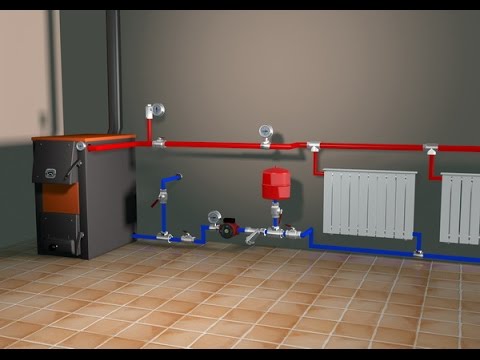

Air locks interfere with the normal circulation of water in the heating system, as a result of which radiators become ineffective.
If there are pumps for forced circulation of water in the system, they must be turned off before performing the air bleeding procedure.
Video: how to air the system ↑
How to install hand models
The Mayevsky crane is screwed into the adapter. Usually, there are no problems with the selection of diameters, since this device is included in a mounting kit for radiators. Only when assembling, you need to remember that if you put on the radiator on the left, you must first screw the air vent into the adapter, tighten the thread (with a regular wrench, without applying excessive force). After that, the assembly can be screwed into the manifold. The whole installation.
Another version of the handheld device is easy to install. The process is the same as for the automatic installation. In this case, it is also desirable to install in a pair with a shut-off valve (the "Mayevsky" valve cannot be removed without stopping the system). If you mount it with a valve, screw the valve into the adapter from the mounting kit. Then install this assembly on the radiator. And then you can screw the air vent into the installed valve.
Sometimes, to ensure tightness, a winding is wound on the thread. Only you don't need to wind it a lot, and you can't use paint. Better to take some sealant (only sealant can be used).
How the Mayevsky crane is installed is demonstrated in the video.
Selection of radiator taps
What taps to put on heating radiators so that they serve a long time and efficiently? The radiator valve is a spherical structure that is designed to regulate the flow of liquid and at the same time connects the pipe to the battery. Install it on the bypass, risers, in the upper part of the radiator, where air usually accumulates.
In order to choose a tap for connecting a heating radiator, you need to pay attention to the following points:
- the diameter of the pipe into which it will be installed (DN, in millimeters or inches);
- required working pressure (PN, varies from 15 to 40 bar and more);
- connection method (external or internal thread, "American");
- purpose of the product, operating conditions.
To understand which taps for batteries are better, you need to take into account the relative position of the inlets and outlets of the tap and the radiator.
Types of air vents
Manufacturers offer two different types of air vents for the heating system:
- Automatic.
- Manual.
Their main difference lies precisely in the name, since automatic air vents do not require human intervention. All excess air is removed autonomously, and to control manual equipment, which is also called Mayevsky's crane, it is necessary to constantly perform certain actions.
Automatic air vents for heating systems are installed directly on the pipes. It is necessary to correctly choose the place in which, according to experts, unwanted air will accumulate. These points are almost always the highest points in the heating system. Also, with automatic equipment, it is often required to install heating filters, which will help prevent possible clogging. This problem is relevant in old apartments. Manual air vents are installed directly on the battery itself, and they can only be adjusted with the help of special tools (physical force is required).
Note! Instead of air vents, many people use ordinary taps that are outdated. They don't do that well with the air, but their only advantage is that stagnant water also goes away!
